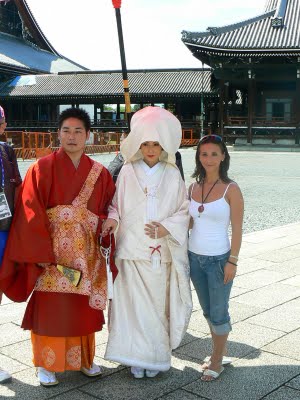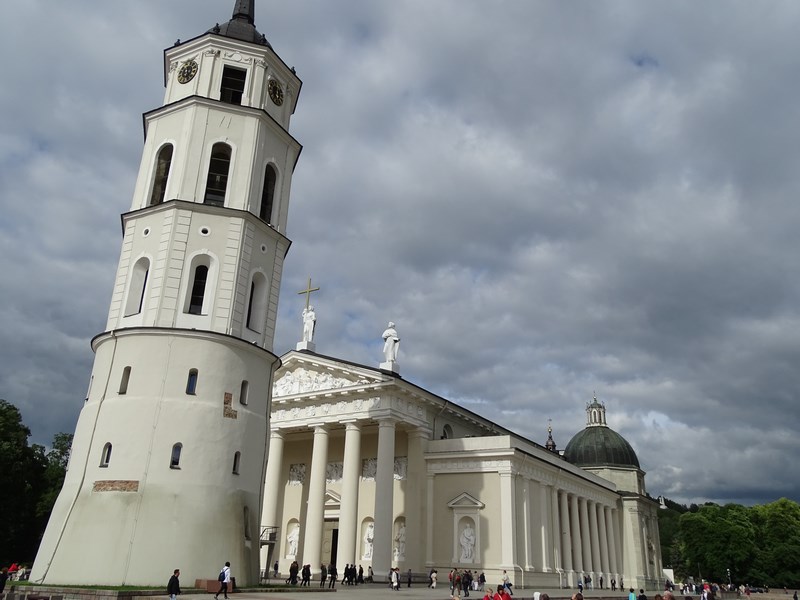Classic Japan between Nara and Kyoto. Episode 2 – Kyoto
A couple of days later, again on a train ride, this time, destination Kyoto. Expectations are set higher, as Kyoto is described as the quintessence of classic Japan. Furthermore, if Nara has only 8 sites on the UNESCO list of World Heritage, Kyoto owns more than double – inside the city there are no less than 17 UNESCO sites (13 Buddhist temples, 3 Shinto sanctuaries and one castle). Just like in Nara, when arriving in the train station the area has nothing to do with classicism… the train station in Kyoto is a glass and steel monster, looking like a futuristic Cathedral, with an observation point at the 15th floor…But let’s not anticipate.
You don’t even have to get out of the train station, you just simply follow the signs through the underground tunnels, that are so omnipresent in Japan, and you suddenly find yourself in front of the Higashi Hongan-ji temple. You enter the courtyard, then the temple, you take off your shoes and you notice the Japanese people that kneel piously in front of Buddha statues. And when at the exit out of the temple, as you meet a Japanese wedding with the bride and groom dressed in traditional costumes, you cannot but stop to take pictures with the newly weds.
There’s a lot to tell about Kyoto. There are temples everywhere. There are some 1500 Buddhist temples, 300 Shinto sanctuaries, 100 museums and 5000 shops with traditional Japanese art. All the temples and pavilions are quiet, relaxing structures, that invite to meditation. Every temple has a garden – a green oasis with fountains, cascades, green trees, flowers, silence and a lot of peace, far away from the raging world…that lies though a couple of tens of meters away. You simply load with positive energy. Could it be the Feng-Shui?
However, I believe I should mention the major attractions that I have visited (I obviously have missed some, but you really can’t see it all in two days time, especially when in order to really enjoy you should take it easy, not running around and checking all the landmarks). First of all, one shouldn’t miss the Kinkaku-ji, the famous Gold Temple, standard image for Japan, like the Eiffel Tour is for France, or the Parliament House for Romania, a temple lined on the outside with a gold foil, built in 1397 as a recreation villa for the Shogun Ashikaga Yoshimitsu, but burned down in flames in 1950 from a fire started by a monk, who was obsessed by destroying this monument. Fortunately for the millions of tourists that came afterwards, the temple was rebuilt in 1955, following the exact initial design plan. There are numerous other temples, like the Ginkaku-ji – the Silver Temple, that despite of the fact that it doesn’t have any trace of silver, was named this way because the same Shogun Ashikaga Yoshimitsu wanted to silver plate the entire pavilion but lacking the money, he didn’t do this anymore. All the people called this building “the Silver Temple” in order not to hurt the Shogun’s feelings. Even if it doesn’t have any silver, the Zen garden around the pavilion and the whole natural décor deserve every effort to see this temple.
Kyoto was for centuries the capital of Imperial Japan. Therefore obviously there has to be an imperial complex. Right in the center (Kyoto has around 1,5 million inhabitants, being the seventh largest city in Japan), in the middle of a huge park lies the Imperial Japanese complex. It is free for visiting in an organized tour after being registered at the imperial secretariat. It’s a typical Japanese tour with a guide carrying a megaphone and keeping her “children” close. She speaks English when the tourists are all gaijin. Don’t expect wonder- palaces, the buildings are pretty modest but the whole feng- shui of the place is amazing.
Before leaving Kyoto. it’s mandatory to spend the evening in the Gion district, a historical district, peaceful with narrow streets full of restaurants, bar and traditional places. This is where the Geisha districts are and if you want to see one, well, your best odds in all Japan lay on the small streets in Gion. And you’ll be happy to catch the sight of one, either a junior – maiko, or a senior – geiko, you won’t know the difference either way. How to realize she’s a maiko or a geiko? Well, that’s easy, she’s wearing a kimono (it’s not unusual to see women walk around on the streets dressed in kimonos without being geishas), but have their faces whitened, as if painted with chalk.
Unfortunately, I visited Japan in august, but if you’re lucky enough to be on this island during spring time, all this experience will be much, much more profound…there will be blossomed cherry trees.
How to get to Japan
Lots airlines fly towards Japan, but the prices are pretty high because of the lack of low cost airlines. However, from Europe, you can find sometimes excellent fares from Aeroflot and from US, watch the Chinese airlines.
When to go
Try to go during spring when the cherry trees are blossoming. During summer time it can be really hot and humid, that will make you feel like you’re swimming in a soup bowl.
Where to eat
Japanese cuisine is sensational without having the derails of the Asian spices. At most restaurants, when entering you’ll see some plastic reproductions of the main food courses so you’ll see right from the start how it’s going to look like.
Where to stay
This hurts…it is really expensive. I stayed in Osaka at a Swisshotel, but I traveled on a expense account, it really costs a lot… in Nara it could be a bit cheaper, but Kyoto is one of the cities with the most expensive hotels in Japan – it’s full of tourists and the prices are accordingly…
Pictures of Kyoto:
Traditional Japanese wedding
The golden temple
The golden temple
The golden temple
The golden temple
The market from Kyoto
Imperial Palace
Imperial Palace
Imperial Palace from Kyoto
Souvenirs
Kyoto Fast food
Gion streets














I’ve heard stories that Japanese students put on kimonos and pose for tourists’ photos just to have fun at those gaijin thinking they are real geishas 🙂
For sure, you can find models in kimonos. But those in the pic were actually tourists 🙂